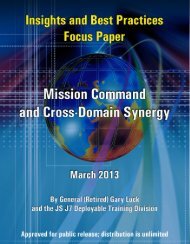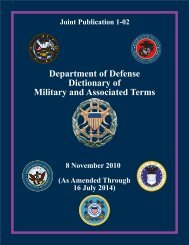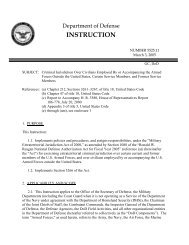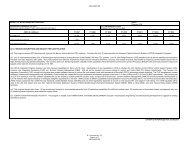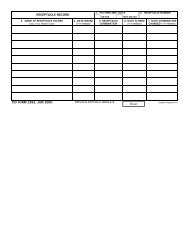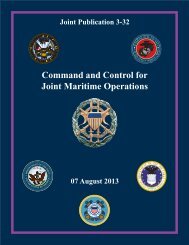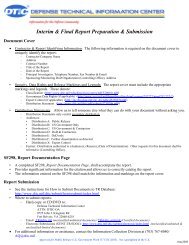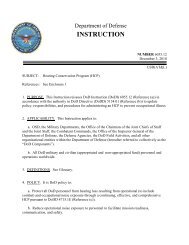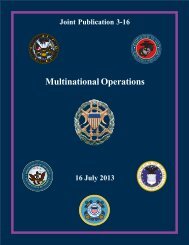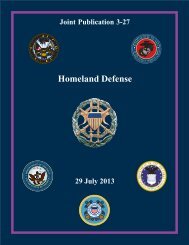JP 1, Doctrine for the Armed Forces of the United States - Defense ...
JP 1, Doctrine for the Armed Forces of the United States - Defense ...
JP 1, Doctrine for the Armed Forces of the United States - Defense ...
You also want an ePaper? Increase the reach of your titles
YUMPU automatically turns print PDFs into web optimized ePapers that Google loves.
Joint Command and Control<br />
purpose is constant: analyze <strong>the</strong> situation and need <strong>for</strong> action; determine <strong>the</strong> COA best suited<br />
<strong>for</strong> mission accomplishment; and carry out that COA, with adjustments as necessary, while<br />
continuing to assess <strong>the</strong> unfolding situation.<br />
b. Estimates, Decisions, and Directives. These processes are iterative, beginning with<br />
<strong>the</strong> initial recognition that <strong>the</strong> situation has changed (e.g., change <strong>of</strong> mission, change in <strong>the</strong><br />
friendly or adversary situation), requiring a new decision by <strong>the</strong> commander. The staff<br />
assembles available in<strong>for</strong>mation regarding <strong>the</strong> adversary, friendly, and environmental<br />
situations and assists <strong>the</strong> commander in analyzing <strong>the</strong> mission and devising COAs. The staff<br />
<strong>the</strong>n analyzes <strong>the</strong>se COAs and <strong>the</strong> commander makes a decision. This decision identifies<br />
what <strong>the</strong> command is to do and becomes <strong>the</strong> “mission” paragraph <strong>of</strong> a plan or order. An<br />
estimate process, as described in <strong>JP</strong> 5-0, Joint Operation Planning, may be used by<br />
commanders and staffs during <strong>the</strong> preparation <strong>of</strong> estimates and directives. Simulation and<br />
analysis capabilities can assist in correlation <strong>of</strong> friendly and adversary strengths and<br />
weaknesses, as well as in analysis <strong>of</strong> COAs.<br />
c. Follow-Through. Having received and analyzed <strong>the</strong> mission, <strong>the</strong> commander<br />
determines how it will be accomplished and directs subordinate commanders to accomplish<br />
certain tasks that contribute to <strong>the</strong> common goal. Then <strong>the</strong> commander is responsible <strong>for</strong><br />
carrying out <strong>the</strong> mission to successful conclusion, using supporting staff studies,<br />
coordination, and analysis relating to:<br />
(1) Supervision <strong>of</strong> <strong>the</strong> conduct <strong>of</strong> operations;<br />
(2) Changes to orders, priorities, and apportionment <strong>of</strong> support;<br />
(3) Commitment and reconstitution <strong>of</strong> <strong>the</strong> reserve; and<br />
task.<br />
(4) After mission attainment, consolidation and refit in preparation <strong>for</strong> <strong>the</strong> next<br />
15. Command and Control Support<br />
A command and control support (C2S) system, which includes interoperable supporting<br />
communications systems, is <strong>the</strong> JFC’s principal tool used to collect, transport, process, share,<br />
and protect data and in<strong>for</strong>mation. Joint C2S systems must provide quality in<strong>for</strong>mation to<br />
allow relevant and timely JFC decisions and provide feedback on <strong>the</strong> intended outcome. To<br />
facilitate <strong>the</strong> execution and processes <strong>of</strong> C2, military communications systems must furnish<br />
rapid, reliable, and secure in<strong>for</strong>mation throughout <strong>the</strong> chain <strong>of</strong> command. All joint<br />
functions—C2, intelligence, fires, movement and maneuver, protection, and sustainment—<br />
depend on responsive and dependable communications systems that tie toge<strong>the</strong>r all aspects<br />
<strong>of</strong> joint operations and allow <strong>the</strong> JFCs and <strong>the</strong>ir staffs to initiate, direct, monitor, question,<br />
and react. Ultimately, effective C2 depends on <strong>the</strong> right person having <strong>the</strong> right in<strong>for</strong>mation<br />
at <strong>the</strong> right time to support decision making.<br />
For fur<strong>the</strong>r guidance on in<strong>for</strong>mation quality criteria, refer to <strong>JP</strong> 6-0, Joint Communications<br />
System, and <strong>JP</strong> 3-13, In<strong>for</strong>mation Operations.<br />
V-19



